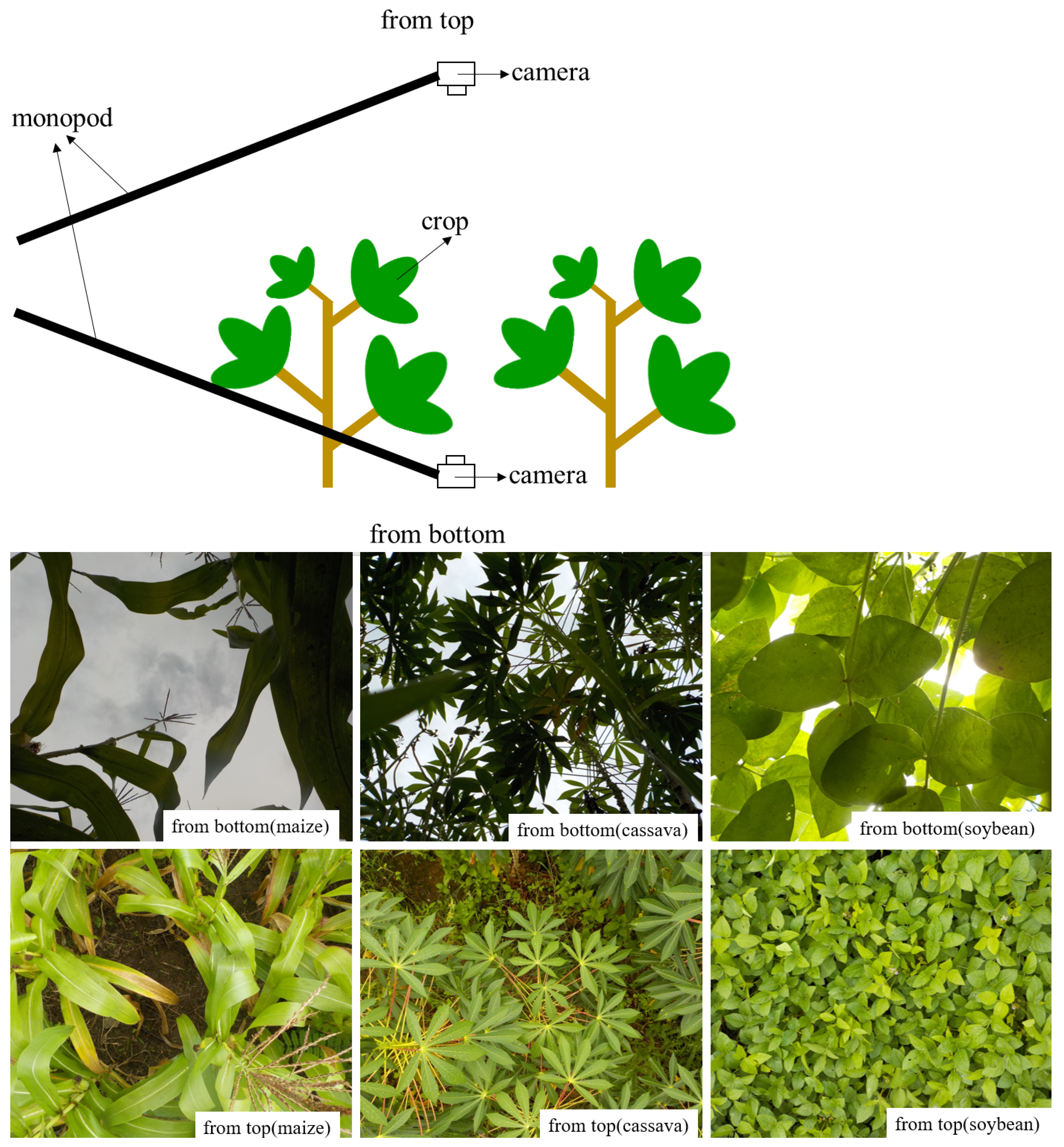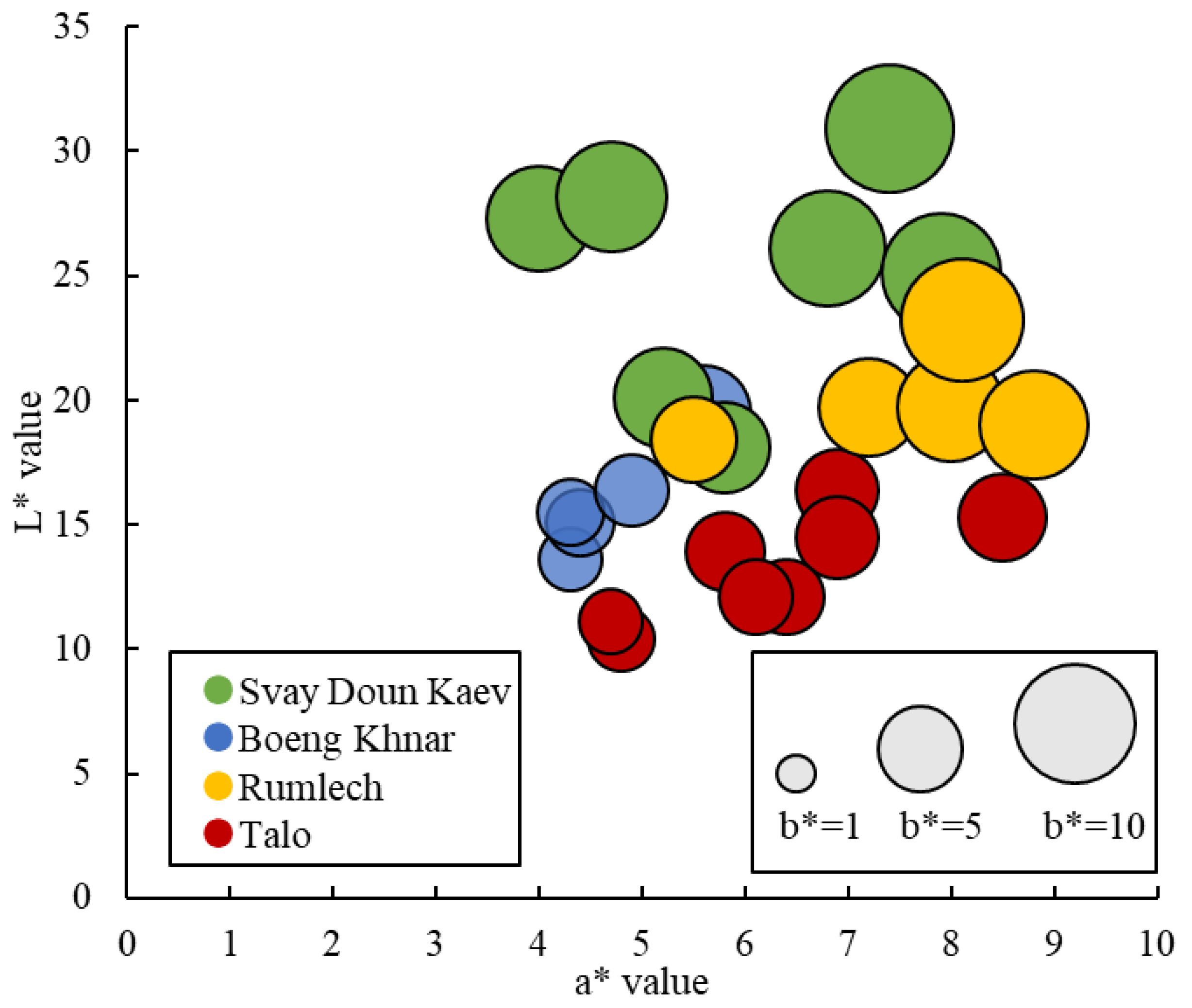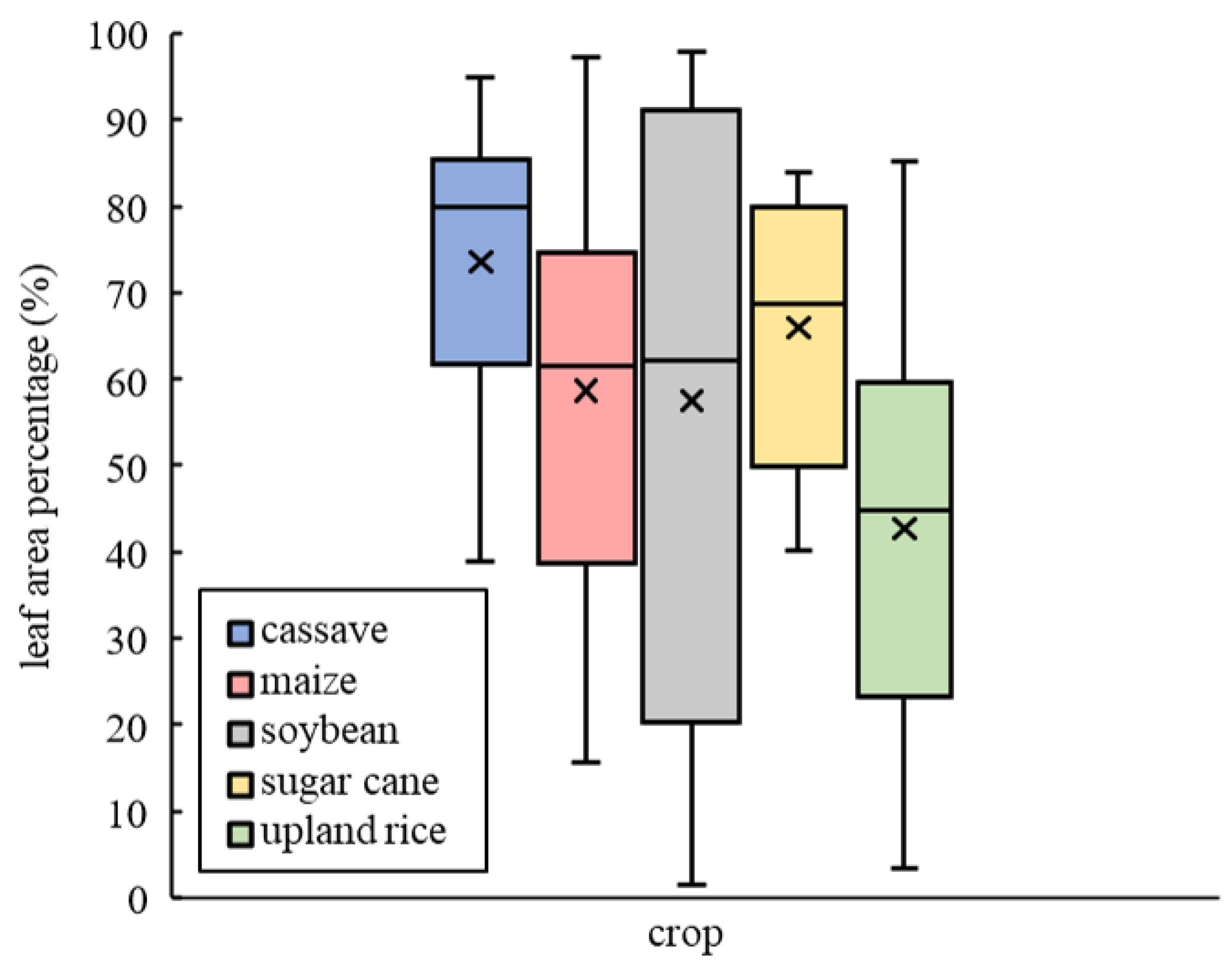Educational Trials to Quantify Agronomic Information in Interdisciplinary Fieldwork in Pursat Province, Cambodia
Abstract
:1. Introduction
2. Materials and Methods
2.1. Outlines of Education Activity
2.2. Student Activities to Collect Agronomic Information
2.2.1. Crop Growth
2.2.2. Soil Characteristics
2.3. Supplemental Measurement
3. Results
3.1. Verification of Leaf Area Percentage
3.2. Summary of Interviews
3.3. Agronomic Evaluation by Student Activities
4. Discussion
Author Contributions
Funding
Institutional Review Board Statement
Informed Consent Statement
Data Availability Statement
Acknowledgments
Conflicts of Interest
Abbreviations
| NDVI | Normalized difference vegetation index |
| LAI | Leaf area index |
| EC | Electrical conductivity |
References
- Kim, J.; Park, H.; Chun, J.A.; Li, S. Adaptation Strategies under Climate Change for Sustainable Agricultural Productivity in Cambodia. Sustainability 2018, 10, 4537. [Google Scholar] [CrossRef]
- FAOSTAT. FAOSTAT, Food and Agriculture Organization of the United Nations. 2018. Available online: https://www.fao.org/faostat/zh/#country/115 (accessed on 17 June 2022).
- Ehara, M.; Hyakumura, K.; Nomura, H.; Matsuura, T.; Sokh, H.; Leng, C. Identifying characteristics of households affected by deforestation in their fuelwood and non-timber forest product collections: Case study in Kampong Thom Province, Cambodia. Land Use Policy 2016, 52, 92–102. [Google Scholar] [CrossRef]
- Un, L.; Sok, S. Higher education systems and institutions, Cambodia. High. Educ. 2018, 70, 80. [Google Scholar]
- Gill, T.; Ricciardi, V.; Bates, R.; James, D. Capacity development in agricultural education and training in Cambodia: A SWOT analysis. J. Int. Agric. Ext. Educ. 2017, 24, 34–50. [Google Scholar] [CrossRef]
- Dany, V.; Bajracharya, B.; Lebel, L.; Regan, M.; Taplin, R. Narrowing gaps between research and policy development in climate change adaptation work in the water resources and agriculture sectors of Cambodia. Clim. Policy 2016, 16, 237–252. [Google Scholar] [CrossRef]
- Chhay, N.; Seng, S.; Tanaka, T.; Yamauchi, A.; Cedicol, E.C.; Kawakita, K.; Chiba, S. Rice productivity improvement in Cambodia through the application of technical recommendation in a farmer field school. Int. J. Agric. Sustain. 2017, 15, 54–69. [Google Scholar] [CrossRef]
- Montgomery, S.C.; Martin, R.J.; Guppy, C.; Wright, G.C.; Tighe, M.K. Farmer knowledge and perception of production constraints in Northwest Cambodia. J. Rural. Stud. 2017, 56, 12–20. [Google Scholar] [CrossRef]
- Yagura, K. Transformation of Agriculture and Its Mechanisms in Pursat Province, Cambodia: Utilization of Untapped Resources and Funding from External Sources. Jpn. J. Southeast Asian Stud. 2021, 59, 101–118. [Google Scholar]
- Kodo, T.; Homma, K.; Kobayashi, S.; Yagura, K.; Hor, S.; Kim, S. Effects of Irrigation Facilities Development on Cultivation Management and Productivity of Rice in Cambodia: Implications Based on Comparison of Adjacent Irrigated and Non-irrigated Areas in Pursat. Jpn. J. Southeast Asian Stud. 2021, 59, 101–118. [Google Scholar]
- Kobayashi, S. Cultural innovation in the face of modernization: A study of emerging community-based care in rural Cambodia. South East Asia Stud. 2020, 28, 231–247. [Google Scholar] [CrossRef]
- Hirooka, Y.; Homma, K.; Kodo, T.; Shiraiwa, T.; Soben, K.; Chann, M.; Tsujimoto, K.; Tamagawa, K.; Koike, T. Evaluation of cultivation environment and management based on LAI measurement in farmers’ paddy fields in Pursat province, Cambodia. Field Crop. Res. 2016, 199, 150–155. [Google Scholar] [CrossRef]
- Hoshikawa, K.; Kobayashi, S.; Hyakumura, K. Transformation of southwestern area of cambodia’s cardamom mountains in the beginning of the twenty-first century: Remote sensing analysis on processes of farmland expansion by pioneer migrants. Jpn. J. Southeast Asian Stud. 2021, 59, 119–145. [Google Scholar]
- Iwahashi, Y.; Ye, R.; Kobayashi, S.; Yagura, K.; Hor, S.; Soben, K.; Homma, K. Quantification of Changes in Rice Production for 2003–2019 with MODIS LAI Data in Pursat Province, Cambodia. Remote Sens. 2021, 13, 1971. [Google Scholar] [CrossRef]
- Richardson, M.D.; Karcher, D.E.; Purcell, L.C. Quantifying turfgrass cover using digital image analysis. Crop Sci. 2001, 41, 1884–1888. [Google Scholar] [CrossRef]
- Saryoko, A.; Fukuda, Y.; Lubis, I.; Homma, K.; Shiraiwa, T. Physiological activity and biomass production in crop canopy under a tropical environment in soybean cultivars with temperate and tropical origins. Field Crop. Res. 2018, 216, 209–216. [Google Scholar] [CrossRef]
- Ryu, Y.; Verfaillie, J.; Macfarlane, C.; Kobayashi, H.; Sonnentag, O.; Vargas, R.; Ma, S.; Baldocchi, D.D. Continuous observation of tree leaf area index at ecosystem scale using upward-pointing digital cameras. Remote Sens. Environ. 2012, 126, 116–125. [Google Scholar] [CrossRef]
- Fuentes, S.; Palmer, A.R.; Taylor, D.; Zeppel, M.; Whitley, R.; Eamus, D. An automated procedure for estimating the leaf area index (LAI) of woodland ecosystems using digital imagery, MATLAB programming and its application to an examination of the relationship between remotely sensed and field measurements of LAI. Funct. Plant Biol. 2008, 35, 1070–1079. [Google Scholar] [CrossRef]
- Schneider, C.A.; Rasband, W.S.; Eliceiri, K.W. NIH Image to ImageJ: 25 years of image analysis. Nat. Methods 2012, 9, 671–675. [Google Scholar] [CrossRef]
- Goto, K.; Hasegawa, M.; Takahashi, M. Diagnostic Approach to Growth of Paddy Rice Using Digital Camera Image Analysis. Tohoku Agric. Res. 2004, 57, 59–60. [Google Scholar]
- Dubbin, W. Soils–past and present. Geol. Today 2001, 17, 225–228. [Google Scholar] [CrossRef]
- Kodo, T.; Homma, K.; Hirooka, Y.; Yagura, K.; Kim, S.; Kobayashi, S.; Hori, M.; Hoshikawa, K.; Hyakumura, K.; Kono, Y.; et al. A Report of Educational Program in Royal University of Agriculture in Cambodia: Water Environment on Rice Cropping in Pursat Province. In Proceedings of the 11th International Symposium on Southeast Asian Water Environment (SEAWE 11), Bangkok, Thailand, 26–28 November 2014; pp. 436–439. [Google Scholar]
- Nagano, T.; Nakashima, S.; Nakayama, S.; Senoo, M. The use of color to quantify the effects of pH and temperature on the crystallization kinetics of goethite under highly alkaline conditions. Clays Clay Miner. 1994, 42, 226–234. [Google Scholar] [CrossRef]
- Rouse, J., Jr.; Haas, R.H.; Deering, D.; Schell, J.; Harlan, J.C. Monitoring the Vernal Advancement and Retrogradation (Green Wave Effect) of Natural Vegetation; Technical Report; NASA STI Repository: Houston, TX, USA, 1974.
- Kirillova, N.; Vodyanitskii, Y.N.; Sileva, T. Conversion of soil color parameters from the Munsell system to the CIE-L* a* b* system. Eurasian Soil Sci. 2015, 48, 468–475. [Google Scholar] [CrossRef]
- Fujisao, K.; Khanthavong, P.; Oudthachit, S.; Matsumoto, N.; Homma, K.; Asai, H.; Shiraiwa, T. Impacts of the continuous maize cultivation on soil properties in Sainyabuli province, Laos. Sci. Rep. 2020, 10, 11231. [Google Scholar] [CrossRef]
- Tanaka, Y.; Watanabe, T.; Katsura, K.; Tsujimoto, Y.; Takai, T.; Tanaka, T.; Kawamura, K.; Saito, H.; Homma, K.; Mairoua, S.; et al. Deep Learning-Based Estimation of Rice Yield Using RGB Image. 2021. Available online: https://www.researchsquare.com/article/rs-1026695/v1 (accessed on 17 June 2022).
- Sourn, T.; Pok, S.; Chou, P.; Nut, N.; Theng, D.; Prasad, P.V. Assessment of Land Use and Land Cover Changes on Soil Erosion Using Remote Sensing, GIS and RUSLE Model: A Case Study of Battambang Province, Cambodia. Sustainability 2022, 14, 4066. [Google Scholar] [CrossRef]
- Sourn, T.; Pok, S.; Chou, P.; Nut, N.; Theng, D.; Rath, P.; Reyes, M.R.; Prasad, P.V. Evaluation of land use and land cover change and its drivers in Battambang Province, Cambodia from 1998 to 2018. Sustainability 2021, 13, 11170. [Google Scholar] [CrossRef]
- Mehmood, S.; Ahmed, W.; Alatalo, J.M.; Mahmood, M.; Imtiaz, M.; Ditta, A.; Ali, E.F.; Abdelrahman, H.; Slanỳ, M.; Antoniadis, V.; et al. Herbal plants-and rice straw-derived biochars reduced metal mobilization in fishpond sediments and improved their potential as fertilizers. Sci. Total Environ. 2022, 826, 154043. [Google Scholar] [CrossRef]
- Homma, K.; Mochizuki, A.; Watatsu, E.; Horie, T.; Shiraiwa, T.; Supapoj, N.; Thongthai, C. Relay-intercropping of Stylosanthes guianensis in rainfed lowland rice ecosystem in Northeast Thailand. Plant Prod. Sci. 2008, 11, 385–392. [Google Scholar] [CrossRef]
- Simarmata, T.; Prayoga, M.K.; Setiawati, M.R.; Adinata, K.; Stöber, S. Improving the climate resilience of rice farming in flood-prone areas through Azolla biofertilizer and saline-tolerant varieties. Sustainability 2021, 13, 12308. [Google Scholar] [CrossRef]
- Asai, H.; Samson, B.K.; Stephan, H.M.; Songyikhangsuthor, K.; Homma, K.; Kiyono, Y.; Inoue, Y.; Shiraiwa, T.; Horie, T. Biochar amendment techniques for upland rice production in Northern Laos: 1. Soil physical properties, leaf SPAD and grain yield. Field Crop. Res. 2009, 111, 81–84. [Google Scholar] [CrossRef]











Publisher’s Note: MDPI stays neutral with regard to jurisdictional claims in published maps and institutional affiliations. |
© 2022 by the authors. Licensee MDPI, Basel, Switzerland. This article is an open access article distributed under the terms and conditions of the Creative Commons Attribution (CC BY) license (https://creativecommons.org/licenses/by/4.0/).
Share and Cite
Ye, R.; Kodo, T.; Hirooka, Y.; Sanara, H.; Soben, K.; Kobayashi, S.; Homma, K. Educational Trials to Quantify Agronomic Information in Interdisciplinary Fieldwork in Pursat Province, Cambodia. Sustainability 2022, 14, 10007. https://doi.org/10.3390/su141610007
Ye R, Kodo T, Hirooka Y, Sanara H, Soben K, Kobayashi S, Homma K. Educational Trials to Quantify Agronomic Information in Interdisciplinary Fieldwork in Pursat Province, Cambodia. Sustainability. 2022; 14(16):10007. https://doi.org/10.3390/su141610007
Chicago/Turabian StyleYe, Rongling, Taisuke Kodo, Yoshihiro Hirooka, Hor Sanara, Kim Soben, Satoru Kobayashi, and Koki Homma. 2022. "Educational Trials to Quantify Agronomic Information in Interdisciplinary Fieldwork in Pursat Province, Cambodia" Sustainability 14, no. 16: 10007. https://doi.org/10.3390/su141610007
APA StyleYe, R., Kodo, T., Hirooka, Y., Sanara, H., Soben, K., Kobayashi, S., & Homma, K. (2022). Educational Trials to Quantify Agronomic Information in Interdisciplinary Fieldwork in Pursat Province, Cambodia. Sustainability, 14(16), 10007. https://doi.org/10.3390/su141610007







